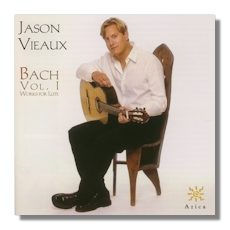
The Internet's Premier Classical Music Source
Related Links
- J.S. Bach Reviews
- Latest Reviews
- More Reviews
-
By Composer
-
Collections
DVD & Blu-ray
Books
Concert Reviews
Articles/Interviews
Software
Audio
Search Amazon
Recommended Links
Site News
 CD Review
CD Review
Johann Sebastian Bach

Works For Lute, Volume 1
- Suite in G minor, BWV 995 (trans. A Minor)
- Suite in E minor, BWV 996
- Suite in C minor, BWV 997
- Prelude, Fugue & Allegro in E Flat Major, BWV 998 (trans. D Major)
Jason Vieaux, guitar
Azica ACD-71250
Bach's interest in the lute was reawakened in the early 1740s (during his time in Leipzig) after meeting renowned lute composers Silvius Leopold Weiss (1686-1750) and Johann Kropfgans (1708-c.1770). The Suite in C minor, BWV 997, and the Prelude, Fugue and Allegro, BWV 998, were written at that time. The E minor Lute Suite, BWV 996, dates from Bach's time in Weimar (1708-1717); while the diminutive C minor Prelude, BWV 999, he wrote in Anhalt-Cöthen in about 1720.
Other of his works Bach rearranged: the cello suite in C minor (number 5) is BWV 995; the violin partita (number 3) is BWV 1006a. Neither the latter nor the C minor Prelude, BWV 999, is to be heard on this CD, which is entitled Volume 1. There is more to come, though Bach did not write enough purely lute music to fill another whole CD so it's going to be other arrangements.
For Jason Vieaux plays a guitar. Some listeners may find the sound of the guitar – less subtle, slightly more fruity, with quite different associations, and potentially louder – off-putting. It has to be said that Vieaux's playing is very sensitive: there is a delicacy, a gentleness and a poise that make the sound quite convincing. Though it necessarily lacks the lute's resonance and rounded, bell-like, liquid timbres.
What's more, you can hear the performer's fingers slide between notes, and the movement of string against fret. Vieaux is tempted, at times, to let the "swing" of his instrument result in excessive vibrato and syncopation – the former can be heard particularly in the G minor's Prelude [tr.1] and the latter in its Allemande [tr.2] and a distinct, and rather jarring, twang – at the start of the Prelude of BWV 997 [tr.14], for example.
This is a very modern Bach, one reconstructed unashamedly in the belief that Bach is "for all time" and his notes can be played anywhere, anyhow. That's not to put it in the same camp as Bach on the Moog, mug or milk bottle. There are moments of pure delight (the middle passages in the G minor's second Gavotte [tr.6], for instance); and others (such as the first Gavotte [tr.5]) where a romanticism closer to Ligeti or Schubert seems to take over… some sense of pace is lost, the phrasing trumps the architecture and the perceived need to project mellowness trumps them both.
In fact whether or not you decide to add this CD (there are of course many precedents for this repertoire's performance on the guitar) to your collection is likely to depend on your preference for one plucked instrument over another. Many will want the melodic ideas of Bach to be conveyed through the rounder, spicier and definitely more genteel and deeper sounds of the instrument for which we know Bach originally wrote them in the case of BWV 995 and 1006a – or at least not hear them on the steelier guitar. Not to take anything away from Vieaux's expertise (which is considerable) is nevertheless to wonder at his rather anodyne approach at times: the Allemande of the E Minor [tr.9], for example, sounds more like a lullaby than a dance. This could come across as a laudable attempt to soften the guitar's attack and thus render it more suitable to the repertoire. At any event there's no doubt that the intent is genuine and honorable. Clearly Vieaux understands the milieus of these dance movement-based pieces, their cultural provenances and their places in the Bach œvre. What's more, no demand of tempo or melodic movement is too much of a challenge to this outward-looking player.
The acoustic of the recording (always particularly important in the case of solo plucked string music) is excellent – neither too dry and close, nor overly resonant or distracting: the instrument really is center stage without blinding us. The presentation of the CD is otherwise adequate, although the slim booklet (actually a folded sheet with relevant material printed on five faces, including a track list and background on Vieaux) very hard to read, being set in a font which drifts in size and is all in capitals. The CD has the air of being directed at Vieaux's "fanbase": he has a strong PR machine and personal presence. But such an appeal to the presentation of his "following" is both built on solid musicianly achievements (Vieaux is an accomplished and active teacher) and on his deserved acclaim in his field, which comes as much from his notable accomplishments as the image he projects.
Copyright © 2009, Mark Sealey




















